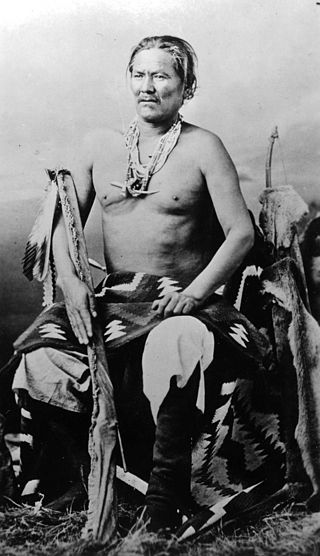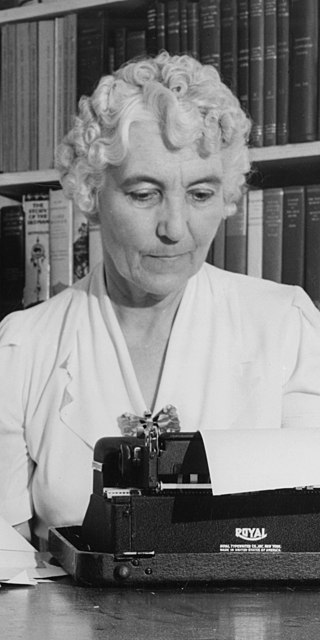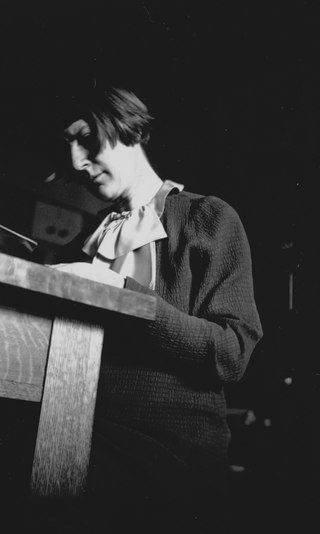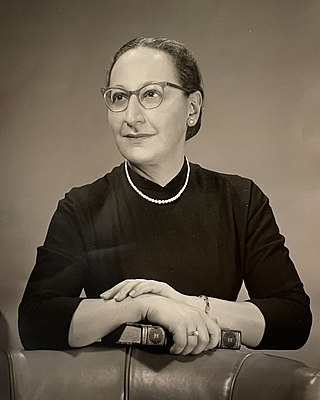
The Hopi are a Native American ethnic group who primarily live on the Hopi Reservation in northeastern Arizona, United States. As of the 2010 census, there are 19,338 Hopi in the country. The Hopi Tribe is a sovereign nation within the United States and has government-to-government relations with the United States federal government. Particular villages retain autonomy under the Hopi Constitution and Bylaws. The Hopi language is one of 30 in the Uto-Aztecan language family. The majority of Hopi people are enrolled in the Hopi Tribe of Arizona but some are enrolled in the Colorado River Indian Tribes. The Hopi Reservation covers a land area of 2,531.773 sq mi (6,557.26 km2).

Navajo or Navaho is a Southern Athabaskan language of the Na-Dené family, through which it is related to languages spoken across the western areas of North America. Navajo is spoken primarily in the Southwestern United States, especially on the Navajo Nation. It is one of the most widely spoken Native American languages and is most widely spoken north of the Mexico–United States border, with almost 170,000 Americans speaking Navajo at home as of 2011.
The Apache are a group of culturally related Native American tribes in the Southwestern United States, which include the Chiricahua, Jicarilla, Lipan, Mescalero, Mimbreño, Ndendahe, Salinero, Plains and Western Apache. Distant cousins of the Apache are the Navajo, with whom they share the Southern Athabaskan languages. There are Apache communities in Oklahoma and Texas, and reservations in Arizona and New Mexico. Apache people have moved throughout the United States and elsewhere, including urban centers. The Apache Nations are politically autonomous, speak several different languages, and have distinct cultures.

Lot Smith was a Mormon pioneer, soldier, lawman and American frontiersman. He became known as "The Horseman" for his exceptional skills on horseback as well as for his help in rounding up wild mustangs on Utah's Antelope Island. He is most famous for his exploits during the 1857 Utah War.

Visual anthropology is a subfield of social anthropology that is concerned, in part, with the study and production of ethnographic photography, film and, since the mid-1990s, new media. More recently it has been used by historians of science and visual culture. Although sometimes wrongly conflated with ethnographic film, visual anthropology encompasses much more, including the anthropological study of all visual representations such as dance and other kinds of performance, museums and archiving, all visual arts, and the production and reception of mass media. Histories and analyses of representations from many cultures are part of visual anthropology: research topics include sandpaintings, tattoos, sculptures and reliefs, cave paintings, scrimshaw, jewelry, hieroglyphics, paintings and photographs. Also within the province of the subfield are studies of human vision, properties of media, the relationship of visual form and function, and applied, collaborative uses of visual representations.

Morris Edward Opler, American anthropologist and advocate of Japanese American civil rights, was born in Buffalo, New York. He was the brother of Marvin Opler, an anthropologist and social psychiatrist.
Clyde Kluckhohn, was an American anthropologist and social theorist, best known for his long-term ethnographic work among the Navajo and his contributions to the development of theory of culture within American anthropology. During his lifetime, Kluckhohn was a member of the American Academy of Arts and Sciences (1944), the United States National Academy of Sciences (1952), and the American Philosophical Society (1952).

The Navajo are a Native American people of the Southwestern United States.
Grenville Goodwin, born Greenville Goodwin (1907–1940), is best known for his participant-observer ethnology work among the Western Apache in the 1930s in the American Southwest. Largely self-taught as an anthropologist, he lived among the Apache for nearly a decade, and learned their stories and rituals. His monograph The Social Organization of the Western Apache was considered a major contribution to American ethnology. It was published in 1941 after his death at age 32, when his promising career was cut short.

The Navajo Livestock Reduction was imposed by the United States government upon the Navajo Nation in the 1930s, during the Great Depression. The reduction of herds was justified at the time by stating that grazing areas were becoming eroded and deteriorated due to too many animals.
Father Berard Haile (1874–1961), O.F.M., was a Franciscan priest and one of the foremost authorities on Navajo anthropology. He entered the Franciscan Order in 1891 and was ordained a priest on June 29, 1898. He served at St. Michael's Mission, a Franciscan mission to the Navajo at St. Michaels, Arizona, and at other missions in the Southwest, from 1901 to 1954, where he developed an interest in Navajo language and culture. He helped devise a written alphabet of the Navajo language and published a four volume work on learning Navajo. In 1929 Haile attended the Catholic University of America and obtained a master's degree. He then accepted the position of Research Associate in Anthropology at the University of Chicago. He made a field trip with Edward Sapir through Navajo land that was sponsored by the Laboratory of Anthropology at Santa Fe, New Mexico. Haile devised a new Navajo alphabet containing over sixty characters. His other major work dealt with the creation story of the Navajo, Diné Bahaneʼ.

Ruth Murray Underhill was an American anthropologist. She was born in Ossining-on-the-Hudson, New York, and attended Vassar College, graduating in 1905 with a degree in Language and Literature. In 1907, she graduated from the London School of Economics and began travelling throughout Europe. During World War I, she worked for an Italian orphanage run by the Red Cross.

Southern Athabaskan is a subfamily of Athabaskan languages spoken primarily in the Southwestern United States with two outliers in Oklahoma and Texas. The language is spoken to a much lesser degree in the northern Mexican states of Sonora, Chihuahua, Durango, Coahuila, and Nuevo León. Those languages are spoken by various groups of Apache and Navajo peoples. Elsewhere, Athabaskan is spoken by many indigenous groups of peoples in Alaska, Canada, Oregon and northern California.

Gladys Amanda Reichard was an American anthropologist and linguist. She is considered one of the most important women to have studied Native American languages and cultures in the first half of the twentieth century. She is best known for her studies of three different Native American languages: Wiyot, Coeur d'Alene and Navajo. Reichard was concerned with understanding language variation, and with connections between linguistic principles and underpinnings of religion, culture and context.
Teresa Montoya is a Diné media maker and social scientist with training in socio-cultural anthropology, critical Indigenous studies, and filmmaking.

Ethel M. Albert was an American ethnologist. Albert conducted ethnological research related to speech, values, and ethics, employing a cross-cultural approach studying different social classes, ethnic groups, and locations. Albert conducted research with the Navajo (Diné) in the American southwest and the Rundi people in the Republic of Burundi. Albert is most well known among late twentieth-century American semiotics researchers for reviving semiotics in the American university curriculum.
Katherine Spencer Halpern was an American anthropologist and educator.
Jennie R. Joe is an American academic, medical anthropologist, and fellow of the Society for Applied Anthropology. Initially trained as a nurse, she was one of the health clinic workers during Occupation of Alcatraz in 1969. She is a professor in the Departments of Family and Community Medicine and American Indian Studies at the University of Arizona. Joe was one of the inaugural board members for the Smithsonian's National Museum of the American Indian and serves on the board of the Urban Indian Health Commission.

Louisa Wade Wetherill lived with her husband and children in remote trading posts among the Navajo people in New Mexico, Utah, and Arizona for more than 25 years and became an authority on Navajo culture. She spoke the Navajo language and became expert in medicinal herbs and plants known to the Navajo, art, especially sandpainting, traditional stories, and weaving. She was known by the Navajo as Asthon Sosi or "Slim Woman."

Irene Emery (1900–1981) was an American art historian, scholar, curator, textile anthropologist, sculptor, and modern dancer. She was known for her pioneering research in systematically describing global textiles, and was a leading authority on ancient fabrics and textiles, and for her published book The Primary Structures of Fabrics: An Illustrated Classification (1966).












